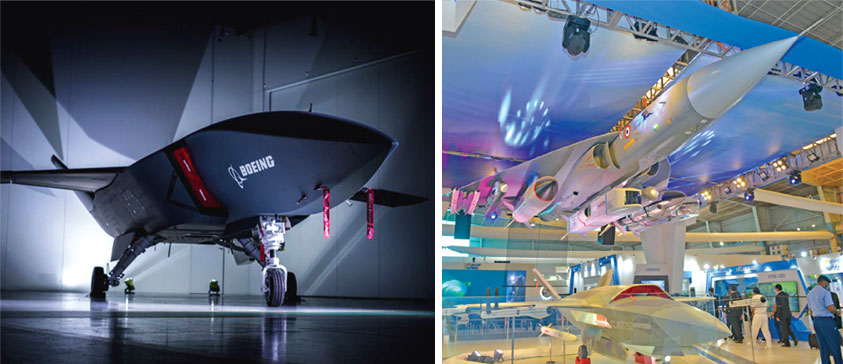HAL committed to man-unmanned programme
Smruti D
Briefing the press about HAL’s ongoing programmes at Aero India 2021, the Hindustan Aeronautics Ltd Chairman and Managing Director, R. Madhavan spoke about the ‘CATS-warrior’ programme. CATS stands for Combined Air Teaming System. He said that HAL will be ready to fly it in four-five years. HAL had invested about Rs 400 crore in the project, deeming it to be the ‘future of HAL’.

The CATS programme is an example of Manned and Unmanned Teaming (MUMT), wherein the manned jet will remain inside the territory and the CATS warriors, autonomous unmanned aerial vehicles, will fly ahead and hit the target nearly 700 kms away. The unmanned jet will carry a set of missiles for air and ground attack.
“We will be ready to fly it in four-five years’ time and we have budgeted Rs 400 crore of our own money for the projects. We are also exploring integrating CATS with Tejas and the Jaguar,” added Madhavan.
The warrior will be controlled by pilots flying in the manned systems that will stay behind. MUMT systems enable the amalgamation of the human brain, which can apply decision making and intuition depending on the situation, coupled with the lethality and precision that a machine offers. The pilot in the manned aircraft can see the situation and terrain on the ground through the imagery being communicated by the warrior aircraft, which is essentially a drone.
While MUMT, as a technology is applicable across land, sea and air domains, work is extensively being put into the air domain currently in India. The United States Army Aviation Centre (USAACE) described MUMT as, “the synchronised employment of soldier, manned and unmanned air and ground vehicles, robotics and sensors to achieve situational understanding, greater lethality and improved survivability.” It is through ‘sophisticated data links’ that MUM-T connects the manned platforms with UAS at different levels of interoperability.
Boeing
World over, different countries and defence manufacturers have been exploring the MUMT technology. In February last year, the US Army conducted manned-unmanned teaming between the Boeing AH-64 Apache attack helicopter and two different unmanned air vehicles (UAVs). An AH-64E, a Textron Shadow RQ-7BV2 Block 3 tactical UAV and a General Atomics Aeronautical Systems MQ-1C Gray Eagle Extended Range UAV successfully worked together to carry out an air-to-ground missile attack at Dugway Proving Ground in Utah in 2020. The three-way manned-unmanned teaming test aims at demonstrating the US Army’s version of Joint All-Domain Command & Control.
An article in Flight Global says, “This is a Pentagon concept that aims to connect soldiers, tanks, artillery, UAVs, satellites, fixed-winged aircraft and helicopters to each other so that anyone can fire upon a target once it is spotted by someone else in the network.” Further, explaining the experiment, the writer, Garrett Reim wrote, “An Apache pilot took control of the RQ-7’s sensor payload for reconnaissance and lased a target. Then, the MQ-1C fired a laser-guided Lockheed Martin AGM-114 Hellfire missile, successfully hitting the ground target from 15,000ft. The trio of aircraft repeated the manned-unmanned demonstration a few days later, hitting a ground target with a Small Glide Munition.”
Boeing’s Loyal Wingman is on offer in the international market. Designed to fly autonomously alongside crewed aircraft, including fighter jets, the system deploys fighter-like abilities and performs a range of missions. Boeing’s ATS Loyal Wingman is a pilot-less jet aircraft almost as large as a conventional, manned fighter and with as much range, capable of flying missions autonomously while maintaining safe distance, commanded by ‘trusted artificial intelligence’, independently or in support of manned aircraft like an F/A-18 Super Hornet, E7 Wedgetail or F-35, that can deploy a variable sensor capability across the ISR spectrum, with a swappable modular payload nose that has a volume of close to 1,500 litres.
Airbus
Airbus, in 2018, demonstrated MUMT for future air combat systems. The company held test flight campaigns, including demonstrations with five Airbus-built Do-DT25 target drones controlled from a mission group commander who was airborne in a manned command and control (C2) aircraft.
You must be logged in to view this content.

